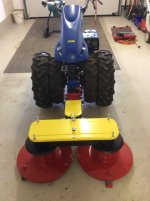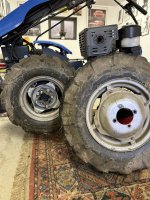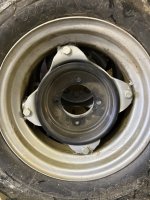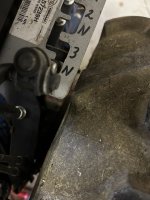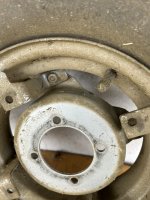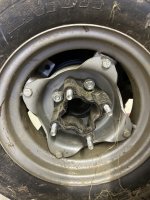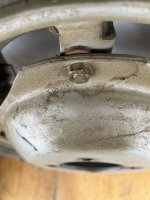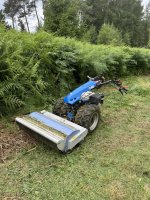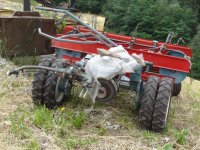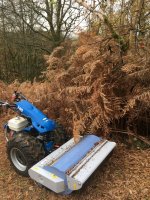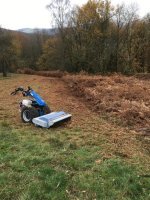Hi 
A few times during the mowing season, I like to give my Berta a good wash down with the garden hose. I do the same at the end of the season, before stowing the mower for the winter. I hope, that keeping the mower clean, well greased and stored in a dry garage, will keep it running well for many years to come. At the same time, it is a good opportunity to check the blades, the bolts and nuts, and the general condition of the implement.
Usually I have disconnected the flail mower from the tractor and raised it to vertical, letting the mower rest on the left-hand side panel. This way the right-hand side panel with the two belts will be at the very top, where they are best protected from the water spray and dirt. This is how the mower typically looks after the wash, with quite a lot of dirt now lying on the ground:
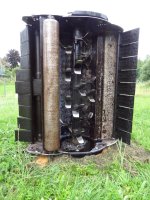
Once as I did this washing, I recalled a video from Earth Tools, where Joel is turning the mower on its side, while it is still connected to the tractor. This might be convenient in some situations, but Joel says that you can’t do that on all the flail mower sizes:
That is correct, as you will run out of ground clearance under the engine before the mower reaches vertical with the wider models, if the tractor is on the standard 5x10x20’’ wheels. I have the 6.5x12x23’’ wheels on mine, so I decided to give it a try with my 34’’ Berta - and it works:
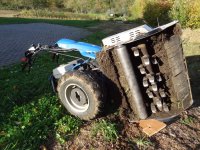
It is a tight fit though, as the engine is sitting firm on the ground in this picture. It only works well this way, as the right-hand side cover is more than an inch wider than the left-hand side one!
Best regards
Jens
A few times during the mowing season, I like to give my Berta a good wash down with the garden hose. I do the same at the end of the season, before stowing the mower for the winter. I hope, that keeping the mower clean, well greased and stored in a dry garage, will keep it running well for many years to come. At the same time, it is a good opportunity to check the blades, the bolts and nuts, and the general condition of the implement.
Usually I have disconnected the flail mower from the tractor and raised it to vertical, letting the mower rest on the left-hand side panel. This way the right-hand side panel with the two belts will be at the very top, where they are best protected from the water spray and dirt. This is how the mower typically looks after the wash, with quite a lot of dirt now lying on the ground:

Once as I did this washing, I recalled a video from Earth Tools, where Joel is turning the mower on its side, while it is still connected to the tractor. This might be convenient in some situations, but Joel says that you can’t do that on all the flail mower sizes:
That is correct, as you will run out of ground clearance under the engine before the mower reaches vertical with the wider models, if the tractor is on the standard 5x10x20’’ wheels. I have the 6.5x12x23’’ wheels on mine, so I decided to give it a try with my 34’’ Berta - and it works:

It is a tight fit though, as the engine is sitting firm on the ground in this picture. It only works well this way, as the right-hand side cover is more than an inch wider than the left-hand side one!
Best regards
Jens
